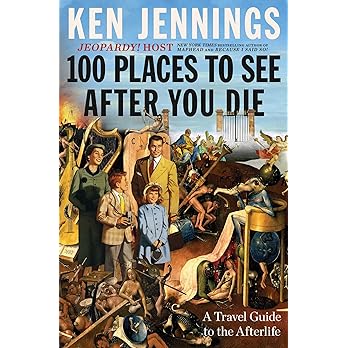Here is the description on Amazon for this 300 or so page book which came out in 2023…..
“From Ken Jennings comes a hilarious travel guide to the afterlife, exploring to die for destinations from literature, mythology, and pop culture.
Ever wonder which circles of Dante’s Inferno have the nicest accommodations? Where’s the best place to grab a bite to eat in the ancient Egyptian underworld? How does one dress like a local in the heavenly palace of Hinduism’s Lord Vishnu, or avoid the flesh-eating river serpents in the Klingon afterlife? What hidden treasures can be found off the beaten path in Hades, Valhalla, or TV’s The Good Place? Find answers to all those questions and more about the world(s) to come in this eternally entertaining book from Ken Jennings.
Written in the style of iconic bestselling travel guides, Jennings wryly outlines journeys through the afterlife, as dreamed up over 5,000 years of human history by our greatest prophets, poets, mystics, artists, and TV showrunners. This comprehensive index of 100 different afterlife destinations was meticulously researched from sources ranging from the Epic of Gilgamesh to modern-day pop songs, video games, and Simpsons episodes. Get ready for whatever post-mortal destiny awaits you, whether it’s an astral plane, a Hieronymus Bosch hellscape, or the baseball diamond from Field of Dreams.”
This book is indeed a cornucopia of unearthly delights and disasters, and one of the first questions it raised for me is– What should we make of this book written by a practicing Mormon who has gone on a Mormon mission, in particular what should we make of its tone— sometimes snarky, sometimes satirical, sometimes comical, sometimes almost flippant? Mormons of course, famously don’t believe in Hell or a genuinely negative afterlife. As Ken says the worse outcome envisioned by Mormons is to end up in the bargain basement telestial kingdom. Nevertheless, that’s still a positive outcome of sorts. And what is especially odd about that particular afterlife theology is that the vast majority of afterlife theologies, from myth, religion folklore, science fiction and elsewhere do indeed have a very vivid depiction of the negative afterlife– call it Hell or something else. Remember that two of the great classics of Christian literature, Dante’s Divine Comedy, or Milton’s Paradise Lost, were criticized for having too vivid and interesting depictions of Hell, and rather boring depictions of heaven. Or consider the painting of Hieronymous Bosch, particularly The Garden of Earthly Delights and the Last Judgment or for that matter Michangelo’s Sistine Chapel back wall last judgment…..
Certainly, one thing that this book does demonstrate is that the belief in some kind of life after death is world wide, and involves almost all imaginable religions, mythologies, literature etc. And just as certainly, this should tell us something not just about human nature and its longing for a positive eternity, but also something about human fears about what happens after one dies. Ecclesiastes 3.11 is worth quoting here “God has set eternity in the human heart, without the possibility that humankind will be able to figure out the work God has done from the beginning to the end.” Yes indeed. I would say this is part of being created in God’s image, and yet as fallen creatures, we have had an infinite capacity to let our imaginations run riot, depicting the afterlife in all sorts of bizarre and distorted ways, as well as a few true ways too. It is striking that actually the Bible doesn’t spend much time describing heaven and hell, although the book of Revelation provides some visual and visionary pictures of things. And what the NT, as well as portions of the OT indicates is that a believer’s final destiny is not somewhere in another parallel universe, a heaven or hell, but rather the final destiny is right here on earth recreated or renewed when God comes to dwell with human beings in our own native habitat. This is both what the end of Daniel and Isaiah and the end of Revelation say clearly, and what various of the sayings of Jesus point to as well.
Ken Jennings then has done a rather good tour guide of human thinking about that other realm, but in the end, it does not describe the final frontier for Biblical believers who take seriously the final positive resurrection and its sequel without equal (cf. Dan. 12.1ff. as well).















